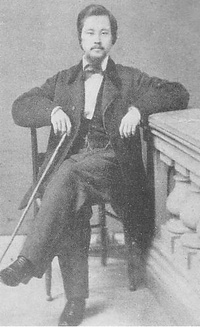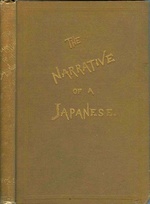Together with the concepts of honor, duty, and self-respect, Gambare—also ganbare—ranks among the top values which characterize the Japanese culture; and you get all kinds of opinions as to whether it means an extraordinary power of determination and endurance, or simple mulishness. Whatever it is, it has proven invaluable in the history of Japanese and Japanese American accomplishment, everywhere. Take the case of Joseph Heco (Hikozo Hamada,) which, to me, appears as one of the finest examples of Ganbare!
Born in Harima, in 1837, during the declining Tokugawa shogunate, he became a student at a temple school, though his parents were only farmers. At twelve, Hikozo lost his father; his mother remarried, this time to a seaman. At 13, his stepfather took him on a trip to Edo. On his return trip home, the ship was wrecked during a storm. Seventeen people, Hikozo among them, survived, drifting at sea for two months. The Auckland, an American freighter rescued them, and brought them to America and they became among the first known Japanese to reach California.
As a goodwill gesture, U.S. Commodore Perry would return the group to Japan, to help ease the start of relations between the two nations. The survivors were shipped to Hong Kong for that purpose; tired of waiting there, like forever, young Hikozo chose to return to the US, to learn better English.
Back in San Francisco, he met Customs Collector, B. C. Sanders; the official and his family became his sponsors. They placed him in a Catholic school in Baltimore, and in 1854 he was baptized and became “Joseph Heco.” He returned to California to expand his education, and in 1857, met California’s Senator William M. Gwin, who took him to Washington, D.C. There he became the first Japanese to be introduced to two American Presidents, Franklin Pierce and James Buchanan. In 1858, barely 21, Heco joined Lt. Commander J. M. Brooke on a survey of the Chinese and Japanese coasts. Then in 1858, he became the first Japanese to become an American citizen.
Somewhat homesick, he decided to return to Japan. The ship bringing him back home stopped at Shanghai where he met Townsend Harris, who, impressed by his accomplishments, appointed him interpreter for the American Consulate in Kanagawa. He served there until 1860, and thereafter decided to become a businessman. In 1862, upon coming back to the US, he met President Lincoln, another first for him.
Heco’s business career was a churning mix of ups, downs and inquietude, just when the Meiji restoration was whipping the political order of Japan. In 1863, he wrote and published his memoirs. In 1864, he helped establish the first Japanese language newspaper, the Kaigai Shinbun, thus becoming “the father of Japanese journalism.”
From 1867 to 1872, he helped many of the rising business entrepreneurs to get a foothold in Japan’s economic surge. In 1872, he served under Finance Minister, Kaoru Inoue, until 1875. He went to work in Kobe, remaining there until 1881, when he became ill. Heco died in 1897, and was buried in the section for foreigners in Aoyama, in Tokyo. Heco’s short life, only sixty years, was a series of frequent challenges, which he overcame through his determination to persevere and accomplish. The luck, which served him so well in the ocean, on land would often maul him harshly; but after each miss, Hikozo sought and found new ways to succeed. Isn’t that the Ganbare tradition?
In Hawaii, there is a very active cultural group honoring his memory, The Joseph Heco Society. Syracuse University, in New York has a vast cache of his invaluable papers. And, for more details about him, see Heco’s own: The Narrative of a Japanese; San Francisco: American Publishing Association (undated). Robert F. Oaks Golden Gate Castaway, California History 82:2, 2004; Akira Yoshimura’s: Storm Rider and Japan Now, Vol. 3, 2003, Japan Embassy in the US.
*This story, now updated, first appeared in the East San Gabriel Valley’s Japanese Community Center’s “Newsette” in November 2006.
© 2006 Edward Moreno







